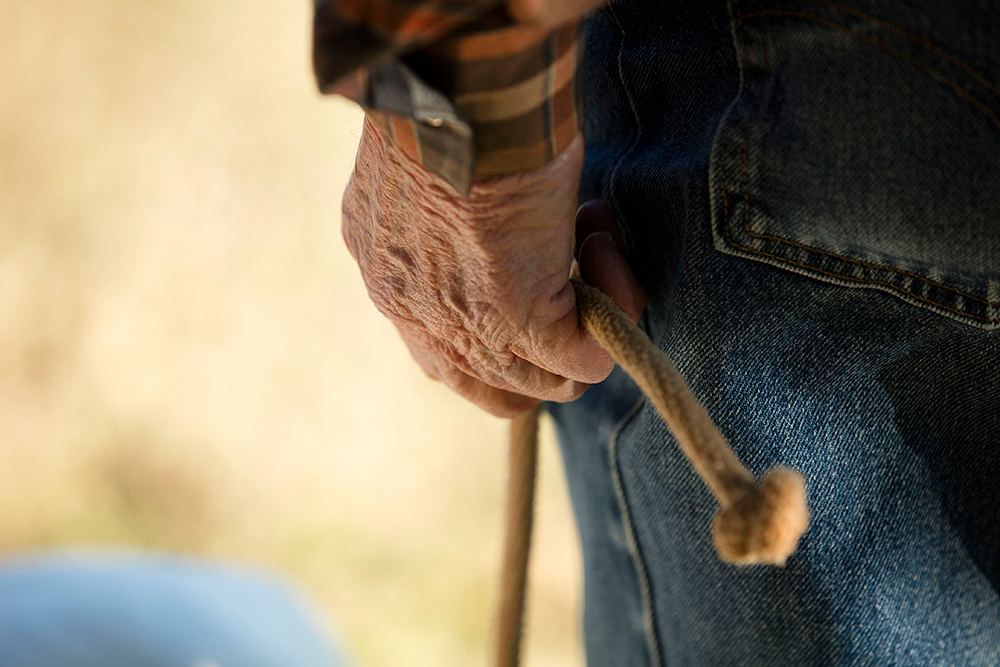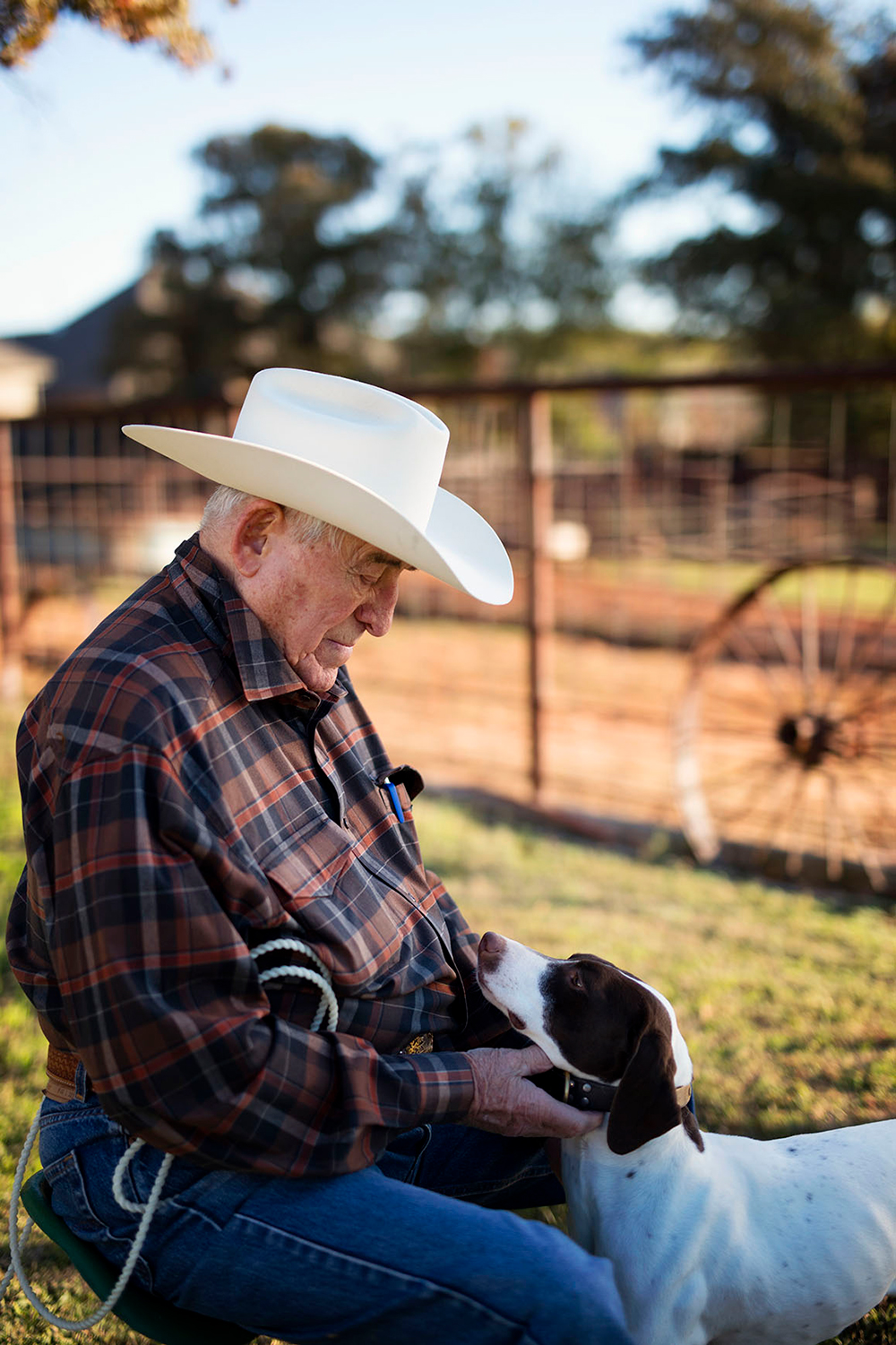Delmar

A couple years ago, preparing to head home after several rewarding days of hunting at Wild Wing Lodge in western Kentucky, I whistled up Tina, my orange-speckled English setter, and gave her the command kennel. She sprang into her crate in the back of the SUV, then turned around so I could do what I always do: bend my face close to hers, cup her lovely head in my hands, gaze into her soft brown eyes, and tell her that she’s my little puppy dog.
I was parked directly in front of the main lodge, and as I pushed through the heavy wooden doors and stepped inside (I was in no particular hurry to leave) a man with a thatch of silver hair came up to me. He was positively beaming but didn’t say a word, just stuck out his hand. I was a bit puzzled but I went ahead and shook it.
“I was watching you out there with your little setter,” the man said, the twang in his voice all but making the windows vibrate, “and I’ve never seen more love pass between a man and his dog. It did my heart good to see that.”
The man doing the talking was Delmar Smith. And if you know anything at all about Delmar Smith, you know why, in a lifetime of fooling with bird dogs, I consider that the greatest compliment I’ve ever received.
The term “living legend” is overused but if it’s true of anyone in the bird-dog world, it’s true of Delmar Smith. Like Elvis, his first name alone is all the identification he needs. And he is our Elvis, the brightest star, the biggest celebrity, the one man whose reputation cuts across all divisions—breed and bird, geography and generation, on foot or horseback, American Kennel Club or The American Field’s Field Dog Stud Book.
No one has witnessed more bird-dog history than Delmar; few have made as much.

He’s a cowboy poet, a rail-fence philosopher, and, in the words of his great collaborator, the writer Bill Tarrant, “the best friend a dog ever had.” In his long, storied, impossible-to-duplicate career, he’s undoubtedly trained more bird dogs, and trained more trainers of bird dogs, than anyone, ever. His holy trinity of concepts—repetition, association, point of contact—has become part of the lexicon, but perhaps his most important contribution has been his incomparable ability to demonstrate the superiority of humane, positive training, while exposing the folly of methods that rely on punishment and coercion.
Equal parts showman and preacher, he’s spread this enlightened gospel to thousands of dog owners in the 55 years since he held his first training seminar for a gathering of Brittany enthusiasts. And whatever or wherever the venue, everyone who’s seen Delmar do his thing has had the jaw-dropping experience of watching him take the wildest, rankest, most ill-behaved dog in the house and, in a matter of minutes, instilling in it the dignified manners of an English butler. It’s a kind of magic act, one that leaves even other professional trainers shaking their heads in awe.
“I’m a pretty fair hand with a dog,” attests Ed Rader, the eminent former pro trainer from Indiana, “but I can’t carry Delmar’s luggage.”
Likewise, thousands of dog owners have embraced Best Way to Train Your Gun Dog: The Delmar Smith Method, authored by Bill Tarrant, as their Bible, if not their Rosetta Stone. Following its original release in 1977, it has been reprinted something like 20 times. “They tell me it’s one of the best-selling dog training books of all time,” Delmar says with a shrug. “But I’ve never set down and read it all the way through.”

Irrepressible and irresistible, his handsome wind- and weather-lined face set off by twinkling blue-gray eyes and a smile as wide as the Red River in flood, he’s 90 years young. A force of nature in a white straw hat, he exerts a gravitational attraction on everyone and everything that enters his orbit. He could melt a glacier, charm the copper off a penny.
From the humblest dirt farmer to the gruffest captain of industry to the snootiest scion of inherited wealth, he treats everyone as equals, accords them all the same respect. There are no strangers to this man, just friends he hasn’t met yet. His homespun wit and wisdom are often compared to those of Will Rogers, which is no coincidence when you consider that they grew from the same soil, having been born and raised 40 miles apart in the Osage-dotted prairies of northeastern Oklahoma—Rogers in Claremore, Delmar in Big Cabin.
For example, have you ever heard of an “eggs-and-daughters town”? Neither had I—until I met Delmar. We were having lunch at a popular café in Vinita, Oklahoma, along with his nephew Ronnie Smith (a highly regarded trainer in his own right) and Ronnie’s charming wife, Susanna Love. At some point in the conversation, Delmar—who, like the guy in the Hank Snow song, has been everywhere—trotted out the term. The forkful of chicken-fried steak stopped halfway to my mouth.
“Did you say an ‘eggs-and-daughters town’?” I marveled. “What on earth is that?”
“Why, it’s one of them little towns so far out in the country that the farmers only come in on Saturday mornin’s,” Delmar replied. “They bring their daughters with ’em, and while they’re doin’ their tradin’ their daughters go up and down the street sellin’ eggs.”

He paused and smiled mischievously before adding, “And if they catch the eye of one of the local boys, they might get asked to the dance.”
That, my friends, is pure Delmar. But then, this is the man who famously proclaimed, “Everything I know about dogs, a horse learned me.” Little wonder that Bill Tarrant described Delmar’s language as “Oklahoma Sanskrit.”
Delmar was born in Big Cabin in 1926, although he’ll tell you that he attended his first field trial in 1925. It’s just that he was still in his mother’s womb at the time.
By his own admission, he was never much for book learnin’. But it was his job every morning—seven days a week, rain, snow, or shine—to saddle his pony, ride out over the shaggy tallgrass prairie, and see that the cattle were fed. The outdoors became his classroom, and it’s doubtful that Mother Nature ever had a better, or more attentive, student. He learned which forces influence animal behavior and, even more importantly, he learned how to interpret, anticipate, and direct that behavior.
“I realized later,” he says, “that that was the best school I could have gone to.”
From the time he was a little boy, his only desire was to train horses and bird dogs. There were plenty of both in the Oklahoma of his youth, along with plenty of opportunities to study the men who made a living doing exactly what he wanted to do. The area was a hotbed of field trial activity; several of the country’s top professional handlers headquartered there, including Dutch Epperson, whose pretty daughter, Jeanne, would one day take Delmar’s hand in marriage. Many other trainers—including some of the biggest names in the sport, giants like Chesley Harris, Jake Bishop, and Ed Farrior—stopped for a month or so every fall, polishing their dogs on quail and prairie chickens in preparation for the Quail Futurity, the Southwestern Club stakes, and other important events.
Even now, Delmar (whose memory is uncanny) can point out the precise spot, just south of Vinita, where they “turned loose” for the big trials—and the one-room country schoolhouse, 10 miles from town, where they stopped for lunch.
“I got to work with a lot of the all-time great dog trainers,” he muses, “and I learned a lot from them. But I learned even more from horse trainers. And the most important thing I learned is that the rough stuff doesn’t work.” That, of course, would become the hallmark of Delmar’s approach: letting the dog train itself. Or, more accurately, setting up situations in which the dog is led to believe it’s training itself. In the dog’s view, the only pain is self-inflicted, and all correction is self-imposed. When something unpleasant is happening, it’s within the dog’s power to make it go away. Conversely, when something pleasant is happening, the dog invariably associates it with the presence of its owner-trainer-handler.
All of which brings to mind another of Delmar’s oft-quoted maxims: “To train like a pro, you have to think like a dog.”
Something else Delmar says, with a conviction born of eight decades of observation, is that many (if not most) great dogs come about by accident. He can cite any number of examples, but perhaps the most compelling evidence is autobiographical. In the mid-1950s, relatively early in Delmar’s career as a pro trainer, he got three Brittanys in for training: Buddington Prince, Towsey, and Holliday Britt. The trio took the Brittany field trial world by storm—Towsey alone won three National Brittany Championships—but Delmar insists that it was “pure accident” at first that everything came together the way it did.
Later on, of course, the “program” became much more orchestrated. Ultimately, five dogs Delmar trained and handled would be enshrined in the Brittany Field Trial Hall of Fame: Towsey (arguably the most influential sire in the history of the breed), Holliday Britt, Holliday Britt’s Bazooka, Bazooka’s Brandy, and Way-Kan Jill. And if Delmar hadn’t quit while he was on top and turned the field trial reins over to his son, Rick, in 1970, who knows how many more Hall of Fame dogs he would have developed. Not at all surprisingly, Delmar himself is a member of both the Brittany and Pointer-Setter Halls of Fame and (also not surprisingly) was one of the driving forces behind the establishment of both.
I once asked Delmar if, after training pointers and setters, he had to take a different approach with Brittanys. The question seemed to amuse him. He smiled, held out his hands, and cupped them.
“Every dog’s born with a little brain,” he said, “and as a trainer that brain’s in the palm of your hand. A child’s the same way; a colt, too. It’s what you do with that brain to get it operatin’ right that matters, not the package it comes in. You have to mold it like an artist molding a lump of clay.”
We may not all have the talent or the patience to create a masterpiece of canine performance in the field; but thanks to the man known simply as Delmar, we all know what tools to use—and how to read the blueprint.


No one has witnessed more bird-dog history than Delmar; few have made as much.
























